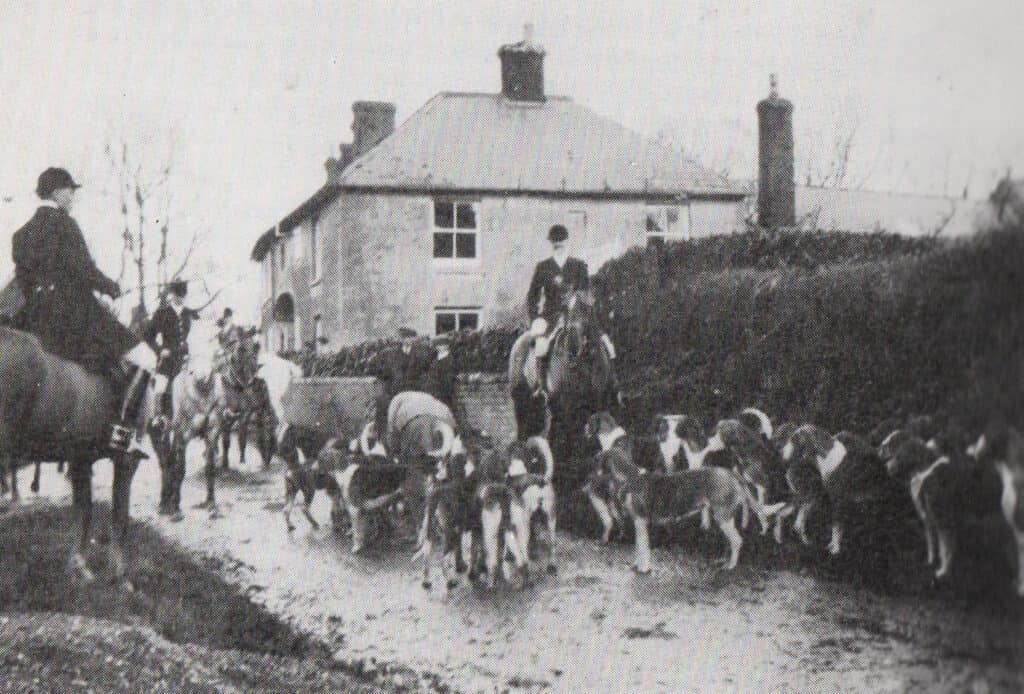If you think our modern TV soaps are racy, you should have lived in north Dorset in the 19th century, says Roger Guttridge.

Fiddleford Post Office aka the Traveller’s Rest c1957. The people are (l-r) Connie Guttridge (née Ridout), Jane and Jim Ridout, relative Ann Minchell and (front) Lassie the springer spaniel and Roger Guttridge aged about seven
An editing error in last month’s Looking Back column affords me an excuse to indulge in an historical tale that is rather close to home.
The insertion of brackets around my first reference to the ‘former Traveller’s Rest’ in my story on the Dorset and Somerset Canal gave the impression that this long- lost pub and the present-day Fiddleford Inn occupied the same building.
They definitely did not, although I confess that the BV editor is not the first to make this assumption.
I have read similar claims elsewhere, including in promotional flyers published by the Fiddleford Inn itself. Although I say it myself, no- one is better placed than I to unravel the story of Fiddleford’s pubs.
The present-day Fiddleford Inn was not a pub at all until the late 1960s, although it was a brewery in the 19th century and probably also the 18th.
It features in one of the family legends told to me by my maternal grandfather, Jim Ridout, about our smuggling ancestor Roger Ridout.
The story goes that Roger beat up an Excise officer who dared to inquire about the contents of a jar that the gang leader was carrying from the brewery to his home in Okeford Fitzpaine. It actually contained fast-acting yeast and the smuggler shook it vigorously, pulled out the stopper and directed it into the officer’s eyes.
Smugglers outwit the law
Roger Ridout’s mother, Susannah Appowell, was a Fiddleford girl, and the smugglers stored their contraband at Fiddleford Mill.
As to the brewery, this was owned by the Adams family for much of the 19th century, and they substantially extended it, adding an archway which gave wagons access to the back yard. During my childhood, the arch was still there, closed to the road by a large green gate.
The outline of the arch can still be seen around the Fiddleford Inn’s front door.
The building was a private house, known as Archway House, until about 1967, when it changed its use to become the Archway House Hotel.
I was 17 then and living next door in a house called Woodview.
This is now Forest View, though I can’t imagine why, as the wood that provides the view has not become Piddles Forest. This property hosted Cressey’s tannery in the mid-19th century.
The Archway House Hotel was initially unlicensed but acquired a liquor licence within two or three years and became the Fiddleford Inn in 1972.
It was Fiddleford’s first licensed hostelry since the closure of the Traveller’s Rest almost 90 years earlier.
The latter pub was set back slightly from the main road, a couple of doors along from Archway House.
The house is known today as Traveller’s Rest but in my childhood was a village shop called Fiddleford Post Office, run by my great-grandparents and grandparents from 1894 to 1965.
The pub that wasn’t…
My great-grandfather, Colour Sergeant James Hilliar Ridout, was working as a racecourse steward in Dublin in 1894 when a relative wrote to say that the Traveller’s Rest had become vacant.
The former Scots Guardsman famously enjoyed a tipple and thought he was on to a winner, so he upped sticks and moved his large family (plus hens and rooster!) to Fiddleford.
He thought he was taking over a pub so imagine his disappointment when he arrived to find that the Traveller’s Rest had lost its licence a few years earlier.

The Portman Hunt outside Archway House, now the Fiddleford Inn
Thus thwarted, James and wife Harriet instead opened a shop and two years later added the Post Office. James returned to his native Okeford Fitzpaine when he wanted a drink, and was often heard singing Onward Christian Soldiers as he staggered home to Fiddleford after a pint or five. He was once cautioned for being intoxicated while on Post Office duty but behaved himself after that.
The Traveller’s Rest was previously called the Bell and dates back at least to 1753, when the landlord was William Dawson.
Fiddleford had two pubs at that time. Widow Ann Churchouse ran the Royal Oak, though the exact location of this hostelry is unknown.
by Roger Guttridge




This inn, as a brewery, was home to my great great grandparents, Philip and Emily Adams, from the 1850s. They then moved to Manor Farm, Folke, but left their eldest son Philip (known as Charles) living at the brewery. I think he remained there, with his family, well into the 20th century.
Absolutely correct. Philip (known as Charles) was my wife’s great grandfather. Certainly a brewer (maltster) he was also a farmer in Okeford Fitzpaine and Staunton Caudle returning to Fiddleford around 1911 , He was a County Councillor and School Manager (i.e. he made voluntary subscriptions to the school) He died in 1921 – none of his family followed him into farming (or brewing)
Very interesting thank you. Good to know that Philip and Emily Adams have other descendants besides this of us in Buckinghamshire.
It is incorrect to say that archways house was unlicensed until 2 or 3 years after I bought it ,as sons the renovations were done I applied for a full on license and was granted it by the local magistrates there was an immediate reaction from the local pubs and Hall and Woodhouse and I had to appeal to the county court in Dorchester who granted me the full on license and I began trading as archway House Hotel. I sold it in 1972. I was MrsERBennett and am now MrsERMoverley. I hope this will put the record straight